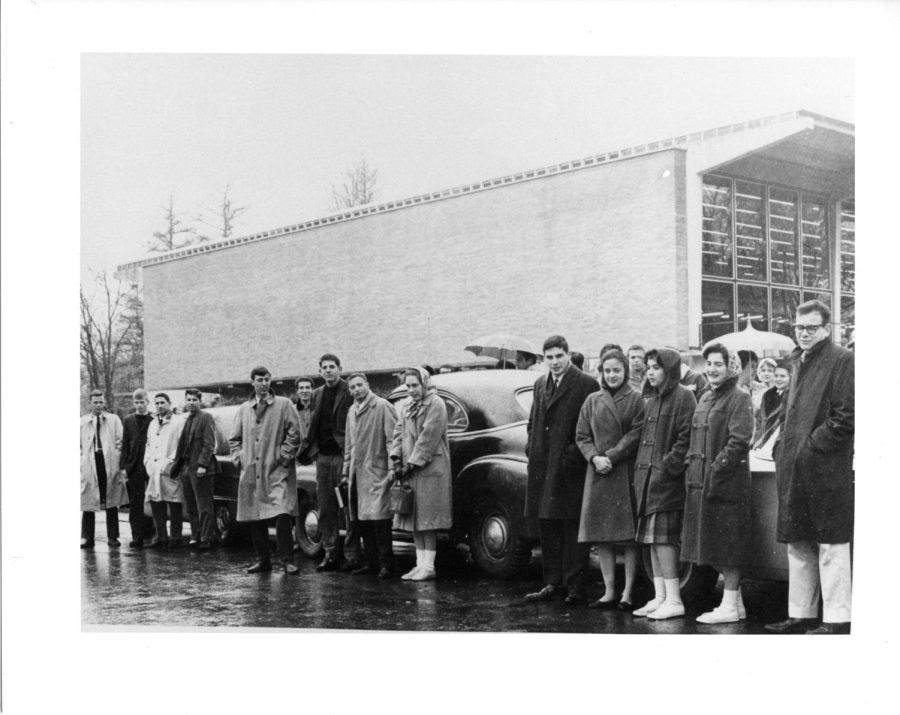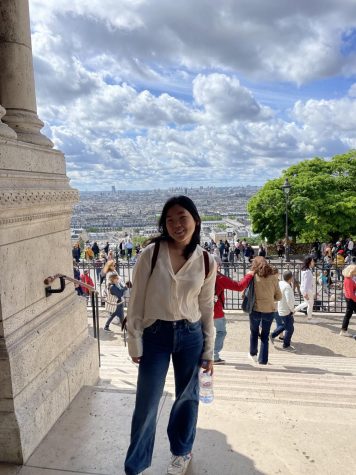History takeover: Grinnell 14
Contributed by Grinnell College library archives
On a rainy November day in 1961, members of the Grinnell 14 paused for a moment outside Burling Library before starting their long drive to Washington, D.C.
October 3, 2022
In November 1961, the U.S. faced the threat of nuclear war as tensions surrounding the arms race reached their peak. As the leaves on the trees began to turn into bright oranges and yellows, Grinnell students remained stubborn. They stood fast on their ideas of rationality and a commitment toward peace, supporting President John F. Kennedy’s nuclear test ban and the “peace race,” wrote Peter Coyote `64 and Terry Bisson `64 for The Grinnell Magazine in fall 2011. Fourteen Grinnellians decided to take a public stance supporting Kennedy. They drove to Washington D.C. to protest the arms race by fasting in front of the White House for three days, an event which is now known as the Grinnell 14.
According to Nancy Pogel in the November 17, 1961 edition of The Scarlet & Black, there was some initial confusion on campus about the stance of the Grinnell 14. The group did not register their fast as a protest but rather as a show of support for presidential nuclear reluctance. While the 1961 Student Government Association and the Grinnell College President, Horace Bowen, did not endorse the Grinnell 14’s efforts as their own political stance, they did permit the group to travel to Washington D.C., wrote the Grinnell Magazine.
The 14 Grinnellians received national attention as they fasted in front of the White House. They were met by the Associated Press and the United Press International, and they were eventually invited into the White House, where they met Kennedy’s National Security Advisor McGeorge Bundy. Bundy offered them “orange juice and advice on how to conduct [themselves] as citizens,” according to the Grinnell Magazine. The Grinnell 14 refused and stayed true to their water-only diet.
Due to their White House invitation, the Grinnell 14 were able to present to the Soviet ambassador, where The Washington Post showed up and took photos of this interaction. They soon became international news.
While the Grinnell 14 was in D.C., Grinnell’s campus showed support by hosting a fast of their own. Over 280 students and 14 faculty members signed up for this “Sympathy Fast.” The fast began after lunch and continued until midnight when students were finally able to drink water. In the Washington Bulletin and The Scarlet & Black, the authors urged the students to help “demonstrate that students are taking serious notice of the world beyond the campus.” Many Grinnell alumni additionally sent calls and well-wishes on their journey and mission when they heard of it, wrote Pogel.
As the Grinnell 14 gained more publicity, other college students found inspiration in their cause, according to student bulletins and the Grinnell Magazine. Bluffton College, in Ohio, sent a group of 15 to Washington, where the students fasted from Saturday through Monday. Oberlin students also attended and Carleton College sent a group of 20 on the next Monday, fasting through Wednesday. As the Grinnell students left, they were met with caravans of students from other institutions taking their place in front of the White House. Students continued fasting for a year. According to the Washington Bulletin, the 14 Grinnellians lit the flame that fueled this peaceful movement.
Ultimately, this group of 14 Grinnellians made their mark on history by helping spark the 1960s student peace movement. They now represent Grinnell’s commitment to social justice and demonstrate the passion that fuels Grinnellians.














































